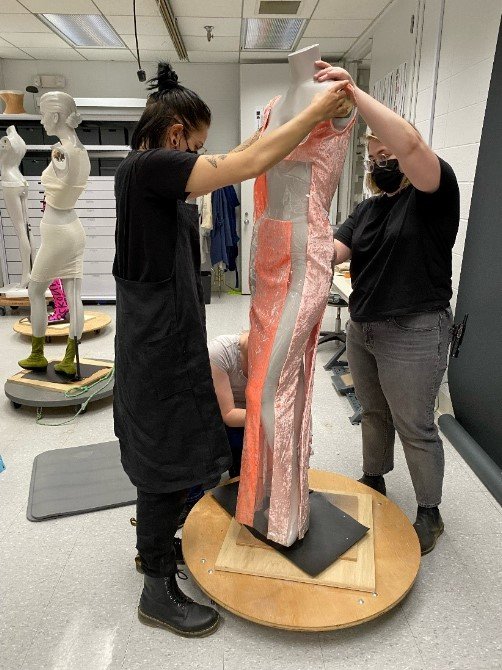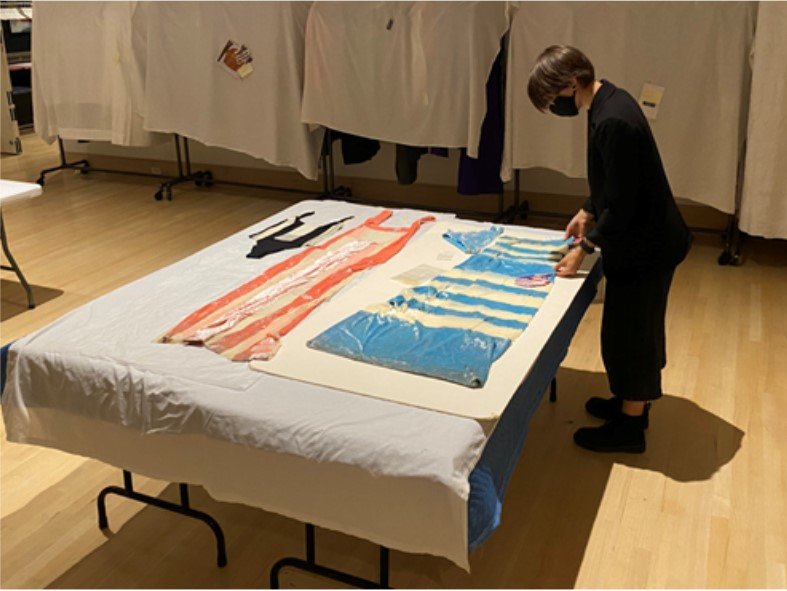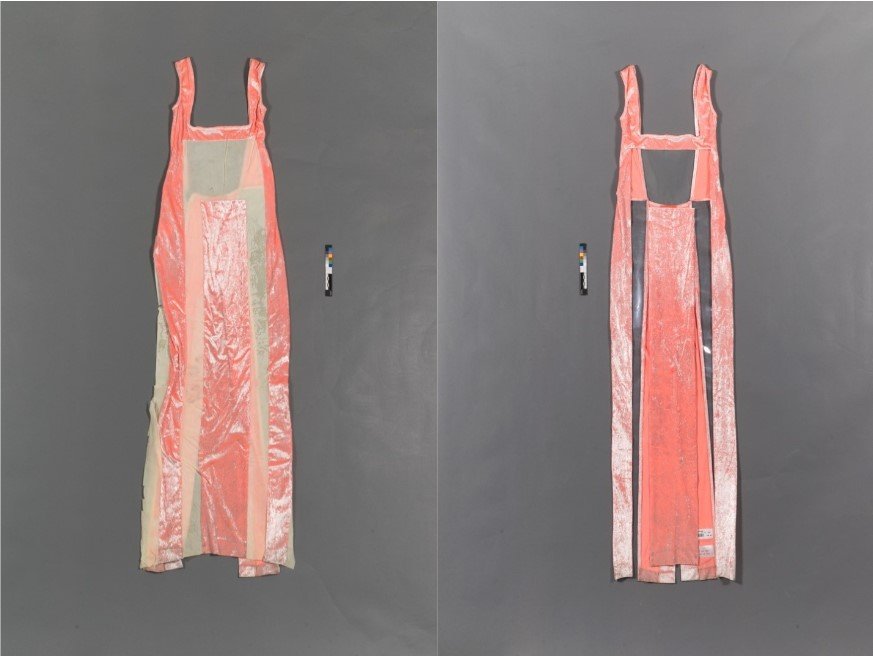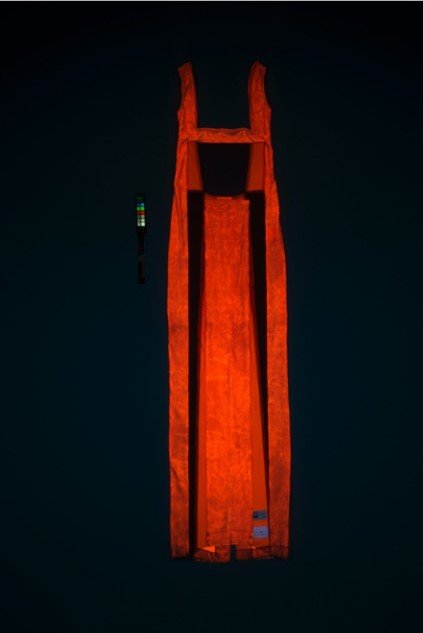Transparent Conservations

Conservation Intern, Kris Cnossen (left) dressing Sprouse’s orange velvet and plastic dress with Mount maker, Emily Freese (right), and Conservation Technician, Erinn Bessler (behind mannequin). Mount making and mannequin dressing are very collaborative in nature.
Artwork: Stephen Sprouse (American, 1953–2004), evening dress, Fall/Winter 1999-2000, velvet, vinyl, glitter. Indianapolis Museum of Art at Newfields, Gift of Joanne Sprouse and Bradford Sprouse in memory of Stephen Sprouse, 2021. 332 © Stephen Sprouse.
Can I tell you a secret? There are things happening behind the scenes at museums that may seem unimaginable, including at the Indianapolis Museum of Art at Newfields. One of them is the careful deconstruction and reconstruction of a designer dress in preparation for Stephen Sprouse: Rock | Art | Fashion. My name is Kris Cnossen, I am studying art conservation at the University of Delaware, and this was one of my assignments during my year-long internship at Newfields. For three months, I researched materials and techniques, drew patterns, and made mock-ups of a Stephen Sprouse (1953-2004) velvet and plastic dress until I finally took it apart completely and then hand-stitched the dress back together.
You see, Stephen Sprouse, king of hand-graffitied-shockingly-bright garments, friend and collaborator of Andy Warhol, Debbie Harry (of Blondie fame), and Keith Haring, loved working with the newest materials and fabrics. He was innovative and uncompromising in his use of materials, releasing collections in the 1980s and 1990s using bespoke fabric he designed and had made in Italy. He even utilized plastic sheeting–that’s right–like a shower curtain, and he did it in a way that looks nothing like what you, I, or your kids would make out of a shower curtain. He made it both punk and high fashion, and he is adored for it.

Photo by Amanda Holden. Artworks © Stephen Sprouse.
Here’s where I come in. I love plastics. My interest in plastics stems from how they have drastically changed the way we live; imagine a world without cellphones. Plastics are at the forefront of technological advancements, they are in our cars, rocket ships, and computer chips. They were and continue to be a big part of textile manufacturing (polyester, acrylic, and nylon are all plastics) and Sprouse designed using them in his fabrics, shoes, and garments. We better understand now that although most plastics do not degrade fully, they often do not survive for long in their original form. Just think of your old swim goggles that turned yellow, sticky, and gross after a summer or two stored in the shed.

Left: Orange velvet and plastic before conservation treatment, January 31, 2022. Right: Orange velvet and plastic after conservation treatment, April 7, 2022.
Artwork: Stephen Sprouse (American, 1953–2004), evening dress, Fall/Winter 1999-2000, velvet, vinyl, glitter. Indianapolis Museum of Art at Newfields, Gift of Joanne Sprouse and Bradford Sprouse in memory of Stephen Sprouse, 2021. 332 © Stephen Sprouse.
This happened to some of the plastic in the Sprouse collection prior to arriving at Newfields, including the orange velvet and plastic dress. The plastic started entirely clear when the dress was created in 1999/2000, but 20ish years later, it’s now hazy and yellowed. It is brittle and breaks apart at the slightest touch. So, I researched plastic and considered my results every night when I walked “my commute,” just 500 feet from the IMA to the Scholar’s Residence, where Newfields is generously providing my housing. After discussing my research with the Senior Conservator of Textiles, Amanda Holden, and the Senior Curator of Textiles and Fashion, Niloo Paydar, I decided to conserve the dress by replacing the original plastic.

My mock-up based on Stephen Sprouse’s evening dress demonstrating how a new plastic would look on a mannequin.
Replacement is an unusual decision in conservation because we work hard to preserve original materials. When preservation isn’t possible, we must be creative with our solutions, often keeping the intentions of the artist in mind. In this case, I decided to replace the plastic on the dress because it was intended to be seen on a body (or a mannequin because human bodies can cause a lot of damage to clothing; if you’ve done children’s laundry, you understand), and in its condition before replacement, it was not a wearable garment.
When thinking through the process of replacing the plastic, I created mock-ups. Mock-ups allow us, conservators, to experiment without altering the original artwork. The first thing I did was pattern the dress, which is essentially drawing out the original construction in two dimensions. Next, I chose a clear archival plastic sheet that we had in the conservation lab and cut the new plastic to size. I then created a reproduction of Sprouse’s dress and put it on a mannequin. I made notes of what wasn’t quite right with the new plastic. Then, I made another mock-up with another plastic. And another. I made four mock-ups in total until I was sure of exactly what plastic to use and that it would honor the original material as closely as possible. I thought through the qualities that different plastics have. For example, archival plastics can be stiff and look like Saran Wrap, it comes in different thicknesses. This experimentation with plastics not only informed what plastic would best be suited for conserving the dress, but also was an exercise that demonstrated to me how intentional Sprouse was with the materials he used.
Now, you might be thinking, “but Kris! The original plastic degraded quickly! Why are you replacing plastic with another, similar, plastic?” You’re right, and that is an excellent question. In order to conserve the physical qualities of the dress that I know through my research were intended by Sprouse, I had to replace the plastic with another plastic. The good news is that the Indianapolis Museum of Art is equipped to mitigate the degradation of plastics with appropriate storage techniques, such as storing it at or under room temperature. The heat in an attic, garage, or storage unit can accelerate degradation (again, think of the heat in the shed where you might have stored your swimming goggles).
After choosing an appropriate plastic, I returned to Sprouse’s dress to start the replacement of the plastic. I started by clipping every stitch to release the old, degraded plastic. Next, I hand stitched the new plastic to the original velvet using the holes that remained after the original stitches were removed. If you think this took a while, you are correct–about 45 hours in total. Yes, I did take stretch breaks and binged some podcasts.

Artwork: Stephen Sprouse (American, 1953–2004), evening dress, Fall/Winter 1999-2000, velvet, vinyl, glitter. Indianapolis Museum of Art at Newfields, Gift of Joanne Sprouse and Bradford Sprouse in memory of Stephen Sprouse, 2021. 332 © Stephen Sprouse.
One last secret: many of Sprouse’s garments are fluorescent, or Day-Glo, which means that when light hits the colorant, especially a blacklight, it reflects some of that light back. This makes the color shockingly bright. The orange velvet dress is so bright under blacklight that it honestly hurt my eyes to look at; what a showstopper this dress would be in a club. You can see the orange velvet and plastic dress, as well as learn more about the incredible designs of Stephen Sprouse in Stephen Sprouse: Rock | Art | Fashion, which is on view in the Indianapolis Museum of Art at Newfields from July 16, 2022 through April 2, 2023. To learn more about me, visit kriscnossen.com. I’ll look forward to seeing you around Newfields!
EXHIBITION CREDIT:
Lead support for Stephen Sprouse: Rock | Art | Fashion is provided by Target, Absolut Vodka and the Jan B. Rubin Art Exhibition Fund. Generous in-kind support is provided by RALPH PUCCI International, KCD PR, and Louis Vuitton. Additional support is provided by Amy Curtiss Davidoff and David Phillips.
HERO IMAGE:
Installation views of Stephen Sprouse: Rock | Art | Fashion in the Allen Whitehill Clowes Special Exhibition Gallery, July 16, 2022–April 2, 2023. Artworks © Stephen Sprouse.




